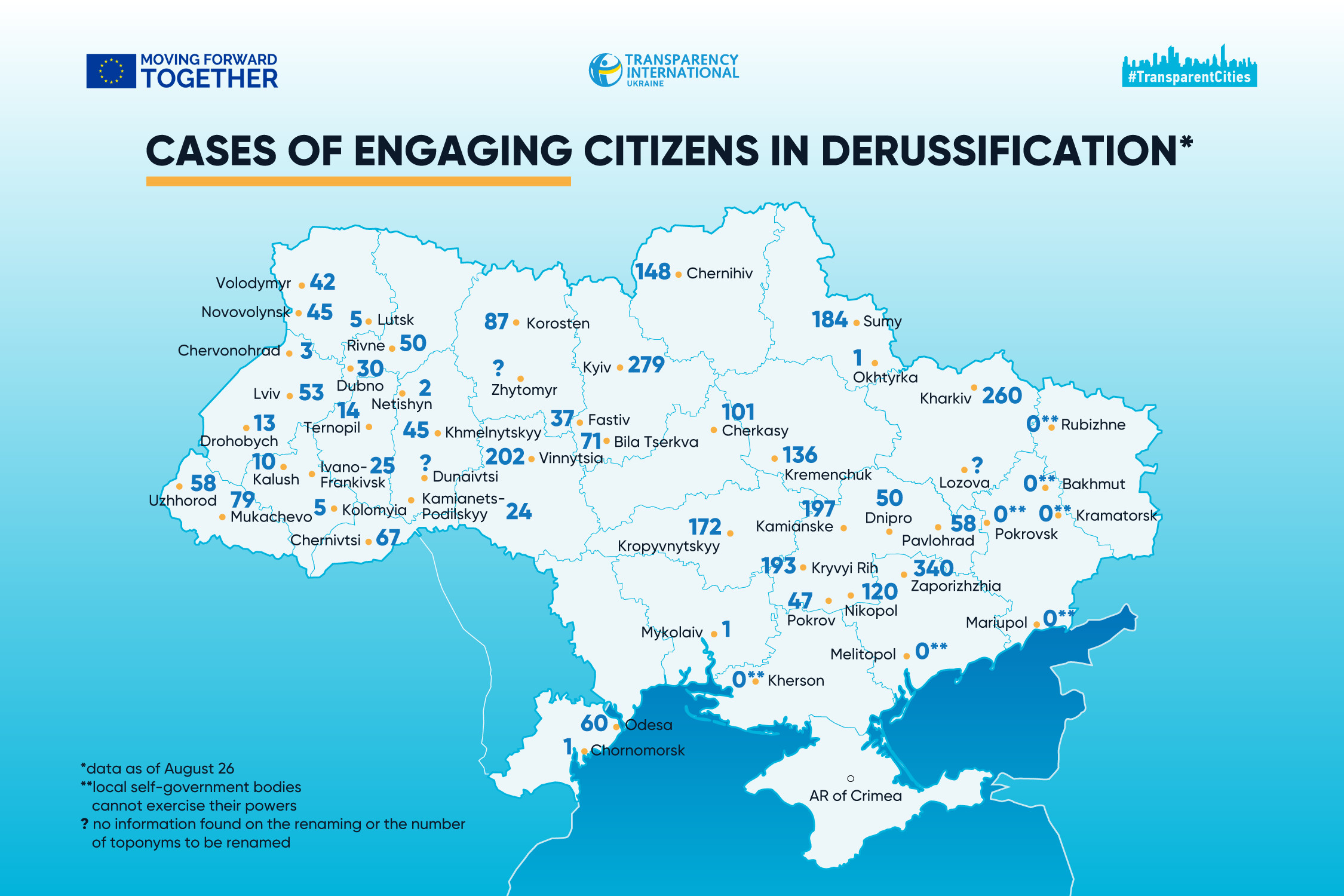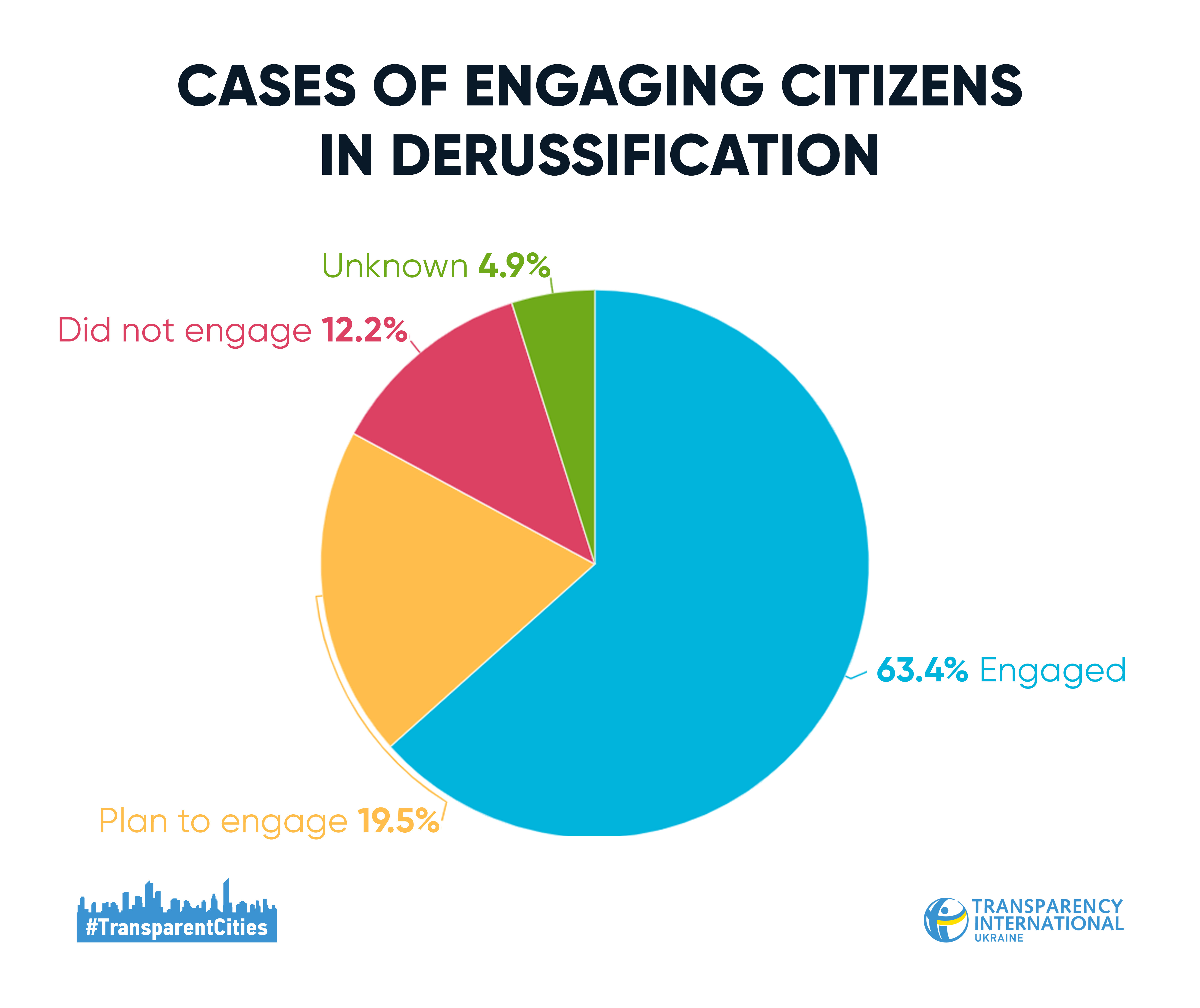With the war, russia really wanted to “denazify” Ukraine. But these plans were not destined to come true (like the rest of them), and instead of denazification, the enemy faced active derussification.
We are increasingly abandoning the idea of russian names for streets, squares, and even ships, trying to create a space free of hostile names, honoring our history and our heroes.
Moreover, such a trend can be traced all over the world. Thus, according to the MFA, in 14 countries of the world, 20 streets and squares received Ukrainian names. It is indicative that in the Czech Republic, Lithuania, Latvia, Albania, Norway, and Canada, the streets and squares on which the diplomatic institutions of russia are located have been named with Ukrainian toponyms.
The Transparent Cities program has analyzed how active the process of derussification of toponyms is, and how it looks like in the first 50 cities of the 2021 Transparency Ranking.
The Process Has Begun
In total, among the 50 cities studied in 41 countries, the process of derussification has taken place or has already been launched. And such high indicators are quite logical because more than 65% of Ukrainians demand to rename toponyms containing russian or soviet names.

At the same time, the process of derussification has not yet begun in 8 cities. Thus, 7 cities (Bakhmut, Melitopol, Kherson, Rubizhne, Pokrovsk, Kramatorsk) are under occupation or close to the line of hostilities, which directly affects the ability of local self-government bodies to carry out their functions. In another 1 city, the leader of the hromada believes that renaming toponyms is not a priority, and it is worth returning to it after the victory. Moreover, regarding 1 city, Dunaivtsi, it was not possible to find information about the change of russian names.
What Are the Cities in for?
The most work in the direction of renaming have cities of the center, east and north of Ukraine. Toponymic commissions in city councils have formed a list of names to be changed, and sometimes it contains two hundred or even more objects.
For example, the toponymic commission in Vinnytsia City Council determined that it was necessary to change the names for almost 190 objects, in Chernihiv — 148, in Kropyvnytskyi — 172, in Sumy — 184, in Kryvyi Rih — 193, in Kamianske — 197. The leading cities in terms of the number of toponyms that need changes are Kyiv and Kharkiv — more than 250 names.
All the listed municipalities have already started the renaming process, but it is not fast. Firstly, the figures are not final because in some cities toponymic commissions continue to expand the list of objects to be renamed. Secondly, the procedure itself should take place with the observance of certain stages, such as the engagement of citizens in the change of names.
Are Citizens Engaged in the Process?
In 26 out of 41 city councils derussifying toponyms, citizens were engaged in choosing new names. That is, in more than 60% of cases, the opinion of the citizens was tried to be considered.

We are talking not only about holding public hearings, but also about the use of electronic tools for selecting names, such as Google forms, mobile applications, or chatbots. It is noteworthy that some city councils conduct re-voting (Kamianske) or on-site consultations with residents (Chernihiv) in debatable or high-profile situations. We should add that the tools are not always convenient or the voting time is not commensurate with the number of toponyms to be renamed. We expect that city councils will consider the shortcomings in the process of citizen engagement and try to avoid them in the future.
In general, there is no clear algorithm for renaming toponyms. In some cities, citizens' opinions are collected first, and then the corresponding commission takes these proposals into account and submits them to the city council for consideration. In some settlements, the authorities responsible for the derussification, before submitting the names for discussion, consult experts of the Institute of National Remembrance. Unfortunately, there have also been cases when city councils made decisions without considering the opinion of residents.
Tips for Cities
Renaming toponyms is an important and at the same time painstaking process that requires balanced approaches. Thus, the changed names will not only identify a certain area, but will also form our new historical consciousness, free from the “russian world.” To do this, we advise cities to:
- To carry out the renaming process in several stages in order to make it easier for citizens and not to turn public consultations into a formality. Thus, in Kremenchuk, 136 toponyms should be renamed, and the city council began the derussification with the first 30 streets. Similar approaches are used by other cities, including Vinnytsia, Zaporizhia, and Lviv.
- Consult the public and a wide range of experts on the new names. This will allow choosing the best option for the name that corresponds to the historical characteristics of the area or the demand of residents.
- Use electronic tools for the convenience of citizens. For example, in Kolomyia and Kropyvnytskyi, citizens voted for updated toponyms in Google forms, in Korosten and Chervonohrad — using the E-EDEM tool, in Kyiv — using a mobile application, and in Kamianske — through a specially created chatbot.
- Not to delay with the process of derussification, it is more on the agenda than ever. This is evidenced by both the above data of the sociological research and the simple understanding that it is impossible to honor the names associated with a country that daily destroys our cities, tortures, and kills Ukrainians.
How we conducted the research
The research was conducted between 23 and 26 August 2022. We took data from open sources (official sites of city councils, Facebook pages, telegram channels of local self-government bodies, the mayors or their deputies, the media) as a basis for the analysis regarding the renaming of toponyms in the TOP 50 most transparent cities of Ukraine according to the results of the 2021 Ranking.
Among the studied 50 cities are 20 oblast centers, and the cities themselves represent all 24 oblasts of Ukraine. Volyn oblast (Lutsk, Volodymyr, Novovolynsk), Dnipropetrovsk oblast (Dnipro, Kamianske, Nikopol, Pokrov, Kryvyi Rih, Pavlohrad), Donetsk oblast (Mariupol, Bakhmut, Pokrovsk, Kramatorsk), Ivano-Frankivsk oblast (Ivano-Frankivsk, Kalush, Kolomyia), Lviv oblast (Drohobych, Lviv, Chervonohrad), Khmelnytskyi oblast (Khmelnytskyi, Dunaivtsi, Kamianets-Podilskyi, Netishyn) are represented the most in the study.